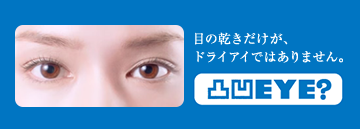Functions of Tears and How They Work
Functions of Tears
After blinking, a film of tear fluid coats the surface of the eye at a certain thickness, and is maintained for a while. This is called tear stability. Tears not only keep the eye moist but also have an important role in maintaining the healthy functioning of the eye.
- Preventing dryness
Tears prevent dryness by coating the surface of the eye, as well as protecting it from external irritants.
- Supplying oxygen and nutrients to the eyes
There are no blood vessels on the surface of the eye, so oxygen and nutrients are transported to the surface cells by tears.
- Preventing infection
Foreign bodies that enter the eye are washed out by tears. Moreover, tears contain a substance called lysozyme, which has an antibacterial action, and works to prevent invasion and infection by microbes.
- Healing damage to the surface of the eye
Tears contain components that heal damage to the surface of the eye.
- Creating a smooth surface on the eye
Tears lubricate and smooth the surfaces of our eyes so that light is refracted correctly, enabling us to see clearly.
Two-layer Structure of Tears
Maintaining tear structure is important for the tears covering our eyes to function normally. Tears have two distinct layers from the outer surface: a lipid layer and an aqueous layer.
Lipid Layer
The lipid layer is secreted by the Meibomian glands on the edges of our eyelids. It prevents the evaporation of tears by covering the outer surface. If Meibomian gland function declines due to aging or inflammation, the secretion of oily substance can decrease, or the composition can change so that the oily substance changes its property to resemble wax, and gland openings can become obstructed. If this happens, tear stability declines, resulting in dry eye syndrome. This type of abnormality is called Meibomian gland dysfunction and is often seen in older patients.
Aqueous Layer
This layer makes up the majority (95%) of tears, and contains various substances including proteins. It performs the key functions of tears, such as supplying nutrients to the cornea, preventing infection and healing damage. It is secreted by the lacrimal gland on the underside of the upper eyelid. In addition, mucus mucin (secretory mucin), which is secreted by the goblet cells on the surface of the eye, helps distribute tears across the surface of the eye uniformly. Recent research has shown that this mucin plays an important role in tear stability.








